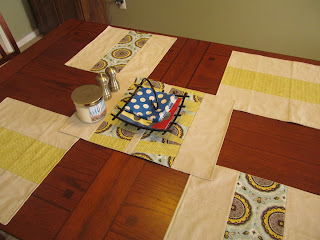Now that you've had plenty of time to finish your beautiful spring placemats, here's what you can do with the scraps. Did I tell you how lovely your placemats were? Great job. :) Now let's make a table runner!
Quilted Spring Table Runner
Finished measurements: 20" x 14"
Seam allowance: 1/2" (unless otherwise stated)
materials
*scrap fabric pattern A
*scrap fabric pattern B
*solid-colored fabric
*coordinating colored thread
steps
1. Make sure your fabric is prewashed.
2. Cut solid-colored fabric to the following size specifications:
*5-1/4" x 15" (x2)
*1-1/2" x 15"
*21" x 15"
Make sure all pieces are pressed.
3. Cut both patterned fabrics into rectangles about 2-3" longer than what you need by anywhere from 3-7" wide. This pattern calls for 5" quilted stripes so I cut my rectangles about 7" x 5" (or so). There's really no exact science for this part as long as the pieces are long enough.
4. Take a fabric A rectangle and a fabric B rectangle and lay them on top of each other RS together at an angle. Stitch the long side of the top piece at 1/4". Press open.
5. Lay another rectangle on top of the one you just sewed RS together at an angle (you'll probably want the angle to be the opposite direction of the one you just made). Sew the long side of the new top piece at 1/4" and press open.
6. Now you'll keep doing this until your quilted strip is as long as you need it. If you're having trouble with the organized chaos of the angles of each piece, you can always place it at the angle you want (like above) and then fold it open to get an idea of what it will look like.
7. Now it's time to cut the strip to the correct size. This is where it really starts to come together. Using a straightedge, cut one side straight using the shortest piece of fabric as a guide (see picture). Then use the straightedge to cut the quilted strip to 5-1/2" wide.
8. Then comes the easy part of cutting it to the correct height of 15". Use your fabric as a guide, and just cut whichever side strikes your fancy; as long as it's 15" tall. Do this twice and you've got your 2 quilted strips! Now for the easy part.
9. Lay a quilted strip on top of a solid-colored piece (5-1/4" x 15") RS together. Stitch a long side at 1/4". Press open.
NOTE: When sewing the quilted piece on your sewing machine, make sure the folds are going under the presser foot backwards so they don't get bunched up under there.
10. Lay the skinny solid-colored piece (1-1/2" x 15") on top of the other side of the quilted strip you just sewed RS together. Stitch a long side at 1/4". Press open.
11. Lay the second quilted strip on top of the other side of the skinny solid-colored piece RS together. Stitch the long side at 1/4". Press open.
12. Lay a solid-colored piece (5-1/2" x 15") on top of the other side of the second quilted strip RS together. Stitch the long side at 1/4". Press open. Now you have the top of the runner done!
13. Lay the runner on top of the large solid-colored piece RS together. Stitch all around (1/2" seam allowance) leaving 2-3" for turning inside out.
14. Clip corners and turn inside out. Press.
15. Choose a color for the decorative stitching and stitch 1/4" all the way around the outside.
Since this piece isn't reversible (like the coordinating placemats), it doesn't really matter which color of the coordinating thread you choose for the stitching. I chose the blue because it popped more than the chartreuse.
16. "Stitch in the ditch" for both sides of both quilted strips (4 stitch lines).
And now you have a beautifully quilted table runner that will match either side of your reversible placemats. This was also my very first quilting project, and I have fallen in love with quilting! If this is going to be your first quilting project, you picked a good one. :)








































